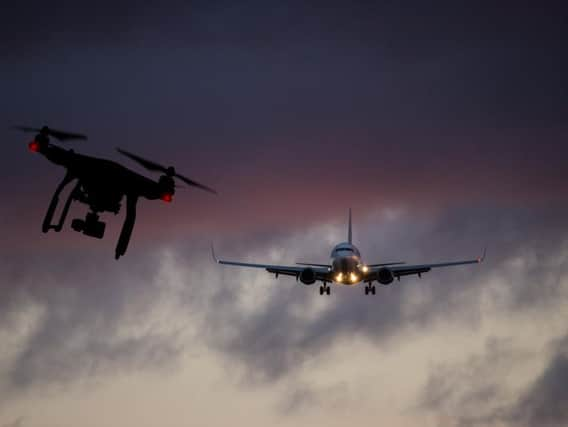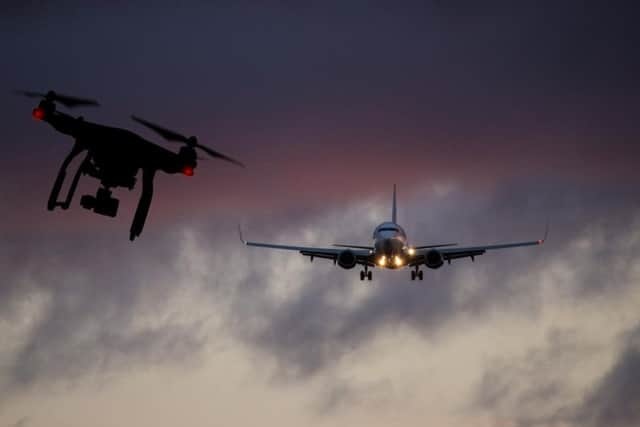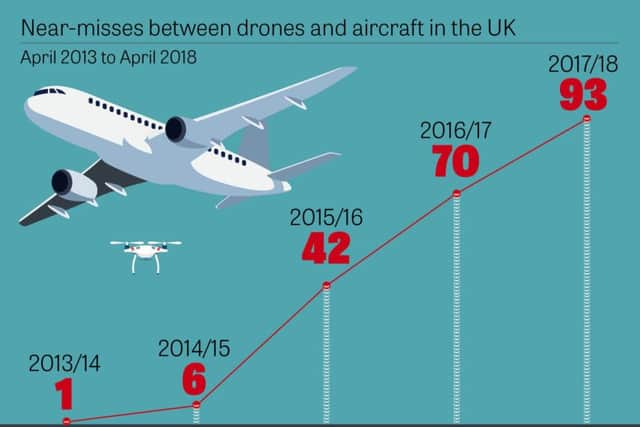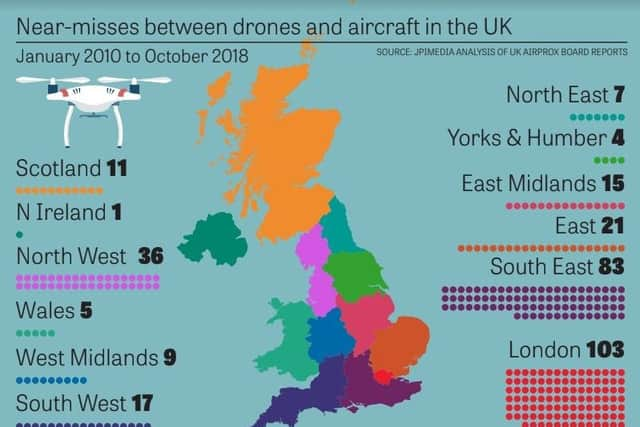Drone flew under B777 airliner’s nose cone in ‘major incident’ at 4,000ft near Newcastle International Airport


The incident is one of SEVEN near-misses involving drones and aircraft in the North East, it has been revealed.
Overall in the UK there have been more than 300 near-misses between drones and aircraft across the UK even before the major disruption seen at Gatwick and Heathrow this winter.
Advertisement
Hide AdAdvertisement
Hide Ad

Drone collisions can cause catastrophic damage to aircraft, making them a real danger to planes and helicopters - and a great risk to lives.
Of the seven near-miss incidents which took place in the North East, three took place in the skies above Tyne and Wear, two in County Durham and two in Northumberland.
The region is served by Newcastle International and Durham Tees Valley Airports, as well as a number of smaller club and private airfields.


In the most serious incident in the North East – listed as a category B major incident – the crew of a B777 climbing near Newcastle International Airport noticed an object which they initially thought to be a blackbird.
Advertisement
Hide AdAdvertisement
Hide AdUpon closing in, the crew identified it as a drone, but it was too late to avoid it and the drone passed “extremely close” just under the nose of the aircraft.
An investigation report said the incident – which took place four nautical miles from the airport – saw the drone pass just 100ft from the commercial airliner.


The aircraft was at an altitude of 4,000ft at the time of the near-miss, which happened on August 27, 2016.
Advertisement
Hide AdAdvertisement
Hide AdThe report states the aircraft was “climbing” four nautical miles from Newcastle, suggesting it had taken off from the city’s airport.
Members of the Airprox Board, which examines incidents and looks to approve safety, said the drone had been operating at a height above that allowed by regulation.
The board agreed the drone had been flown into conflict with the B777, causing a situation where safety had been “much reduced below the norm”.
Another incident involving a commercial flight happened on September 11, 2017, when the aircraft was coming in to land at Durham Tees Valley Airport.
Advertisement
Hide AdAdvertisement
Hide AdAirprox said the drone was being flown at or beyond practical visual line of sight (VLOS) limits and was endangering other aircraft at that location and altitude.
Drone sightings brought 36 hours of chaos to Gatwick Airport in the run-up to Christmas, with runways closed and 1,000 flights affected in what police described as a “deliberate act” of disruption.
Heathrow was also forced to ground flights after drone sightings in early January.
But pilots had begun to report narrowly missing drones in the sky from 2010 onwards, analysis of hundreds of official reports shows.
Advertisement
Hide AdAdvertisement
Hide AdSince the shutdowns, the Government has faced criticism that the events were foreseeable and more should have been done to prevent them.
But the Department for Transport has said there are already laws against such malicious acts.
Aviation Minister, Baroness Sugg, said: “The actions of these drone users were not only irresponsible, but illegal. The law could not be clearer that this is a criminal offence and anyone endangering others in this way faces imprisonment. “Airports have measures in place to counter this threat. The Government is also increasing police powers to clamp down on drone misuse, and extending no-fly zones around airports to ensure our skies are safe.”
Two-thirds of the near-collisions seen in the UK so far involved commercial passenger flights, with drones frequently being flown above regulatory height limits or within restricted airport zones.
Advertisement
Hide AdAdvertisement
Hide AdIrresponsible drone operators are rarely tracked down, the UK Airprox (Aircraft Proximity) Board documents show.
The board, which examines near-misses, noted in one report that “the short battery life of drones means that, with a typical flying time of approximately 15 minutes, it is difficult for the police to respond and catch drone operators flouting the regulations”.
On July 30, 2018, it became illegal for any drone to fly above 400ft.
Despite this, more than 20 near-misses above this height have been reported since the law took effect, demonstrating the difficulty in bringing irresponsible drone users to justice.
Advertisement
Hide AdAdvertisement
Hide AdThere is precedent for drones being deliberately flown near aircraft, the reports show. In 2015, an unknown person hovered a drone over the centre line of Gatwick’s runway, apparently to obtain camera footage. The drone nearly collided with a passenger plane coming in to land, but the operator was never caught by police.
The same year, a paraglider in Derbyshire reported his concerns after a drone deliberately followed him in flight. The UK Airprox Board said the “paraglider pilot had been placed in great peril by the reckless actions” of the drone pilot, who had been committing a criminal offence but could not be traced.
Analysis of UK Airprox Board reports also reveals:
l Nearly three-quarters of near-misses between drones and aircraft happened in controlled airspace, such as around airports
l The highest reported sighting of a drone by a pilot was at 15,500ft, nearly 40 times the legal maximum. It came within 100ft of an Airbus 321 which had left from Doncaster Sheffield Airport on June 3, 2018
Advertisement
Hide AdAdvertisement
Hide Adl While many near-misses happen around the busy airspace of London and the South East, reports have now been logged in every region of the UK
l July is the most common month for near-misses and Sunday the most common day, perhaps a reflection of the number of hobbyists flying drones on warm summer weekends
l The UK Airprox Board is funded by the Civil Aviation Authority (CAA) and the UK Military Aviation Authority.
Jonathan Nicholson, of the CAA, said there was “no debate” about the fact air travel remained the safest mode of transport but the authority wanted to remove any risk of conflict in the air.
Advertisement
Hide AdAdvertisement
Hide AdHe said: “There are some very clear reports from pilots where often drones have been flown well above 400ft. That is totally unacceptable and should not happen.
“We are very clear, the rules are very clear and people should know the rules.”
Drones have grown rapidly in popularity in recent years and can now be bought for less than £20 on the high street.
But they can also pose serious hazards to aircraft.
A strike by a drone could break an aircraft’s windscreen or cause serious damage if sucked into jet engines, propellers or helicopter rotor blades, Government officials have warned.
There have not yet been any collisions between drones and aircraft in the UK, although at least seven such incidents have been logged worldwide.